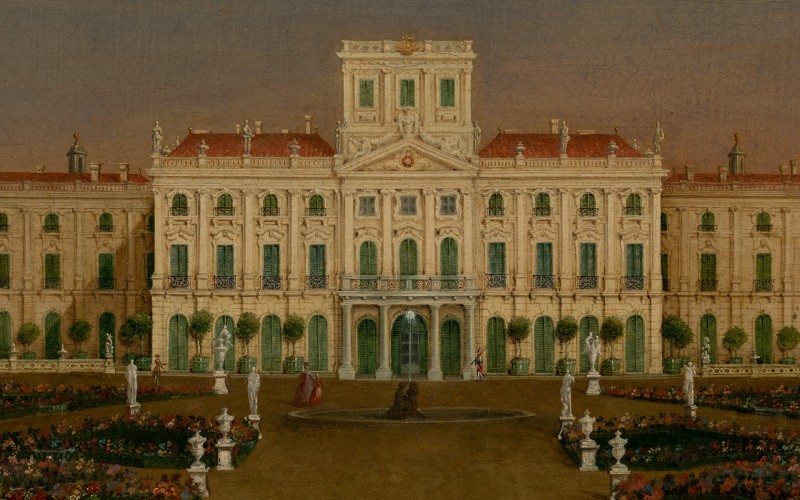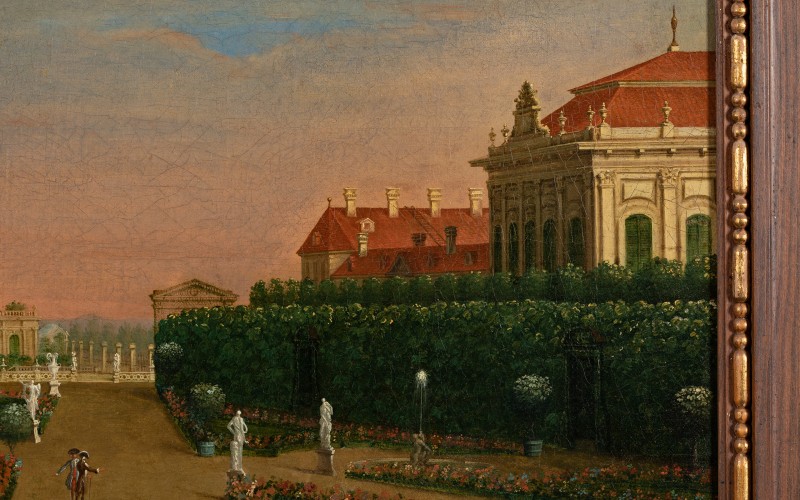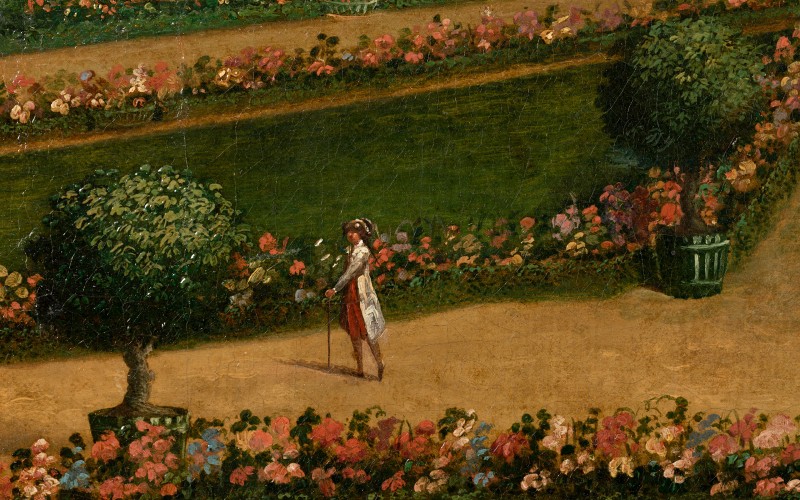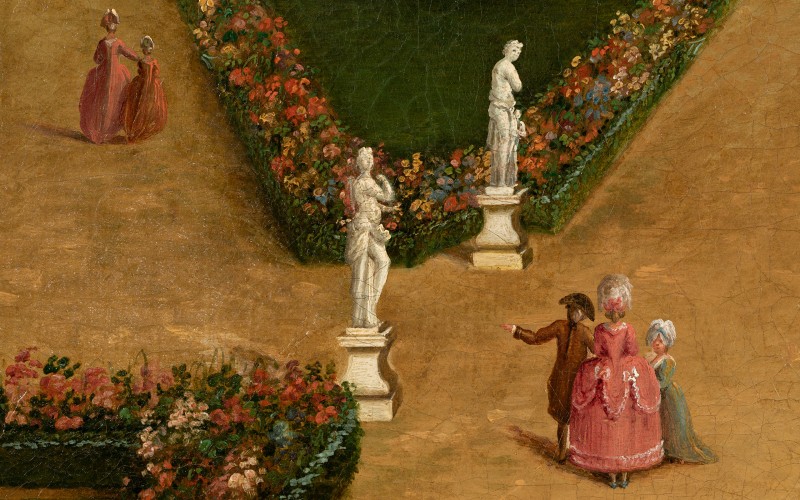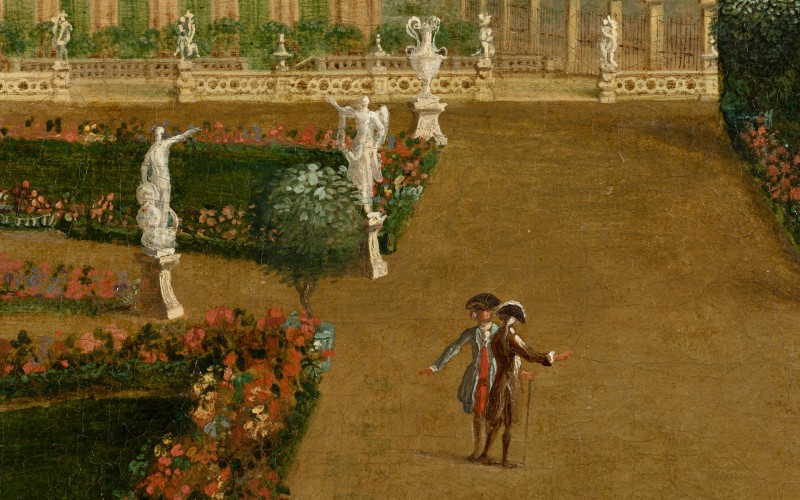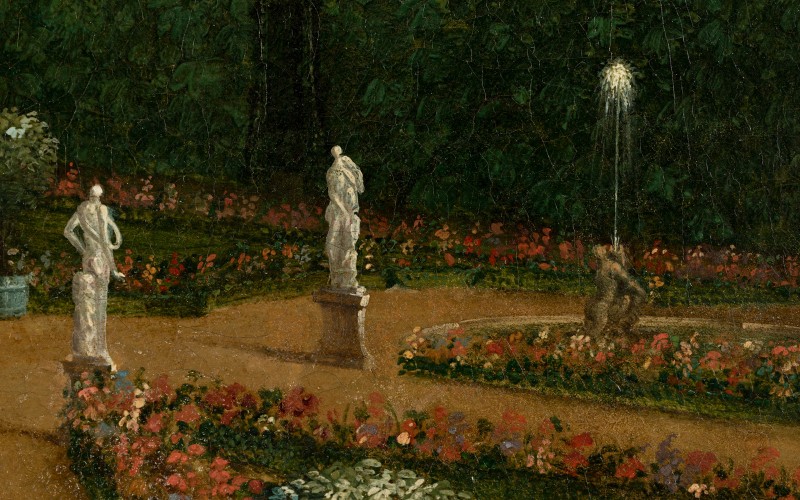Only the painting made from the direction of the gardens has survived, the others disappeared after 1945. The painting was made in a photo-realistic manner, authentically depicting the fine gardens, the southern façade of the palace and the two outbuildings on either side, the opera house to the left and the marionette theater to the right, as well as the tile-roofed building wings connected to them. The painting looks towards the building complex from the central axis of the grand parterre. The sections of mown lawn framed by floral plantings, the fountains, the statuary, and decorative vases, the decorative fruit trees (citrus trees) set in planters with their foliage pruned into a round ball, and the allées of carefully pruned trees along either side of the gardens can be clearly distinguished. The entire well-planned panorama focuses on the main building of the palace. Openwork stone fences decorated with statues and stone vases enclose private gardens along the wings on either side of the main building. A portion of these gardens were sunken so that the foliage of the flowering or fruit-bearing orange trees would be at eye level for those stepping out into the garden from the ground floor of the palace. The outer sides of these private gardens are enclosed by high fences. A single-story side wing can be seen in the back on either side of the main building, and there are large outdoor paintings connected to their outer corners, framing the scene.
Very many of the details depicted can also be seen today at the palace, including the main building itself, as well as the stone fences right next to it. A careful observer may also notice that the single-story wings on either side have been extended, and these sections stand where the outdoor paintings used to be. The locations of the fountains are now indicated by round depressions. It is known from archaeological research into the gardens that the sunken sections depicted in the painting on the sides of the palace looked exactly like they are shown. Based on all of this, it can be justifiably presumed that the minor details of the painting are also genuine depictions, as if it were a photograph. Thus, it is possible to get a better idea of what Fertőd was like at the end of the 1700s by studying the painting.
András Koppány
The painting is held in the collection of the HMA MPDC Hungarian Museum of Architecture (inv. no. 75.11.1).
Bibliography:
Géza Galavics, Eszterháza 18. századi ábrázolásai - a kép, mint művészettörténeti forrás [18th Century Depictions of Eszterháza – Pictures as Art Historical Sources], Ars Hungarica, 2000/1, 37-71
Géza Galavics, Eszterháza 18. századi kertje [The 18th Century Gardens of Eszterháza], 2013 (Kő kövön, F. Dávid)
Kristóf Fatsar, Magyarországi barokk kertművészet [The Art of Baroque Gardens in Hungary], Budapest, 2008, 107-108.

The wealth of details in the paintings of Bartolomeo Gaetano Pesci is perhaps not apparent at first, but innumerable genuine individual details can be seen by looking closer.

This detail from the painting shows the pruned hedge bordering the gardens to the west with one of the fountains in the foreground. The wooden-framed doorways or gates can be seen in the hedge.

The private garden on the western side of the building as well as the main gardens in the foreground can be seen in this detail of the painting. Behind the openwork stone railing, a second stone railing can be seen, which enclosed the sunken portion of the garden. The tromp-l’oeil painting can be seen at the end of the single-story wing to the left.
 This is a close-up detail of the eastern gardens, in which the private garden located here can again be clearly seen. In front of this, the painting depicts statues and a stone vase standing on pedestals in detail. The design of the floral border can also be made out clearly. The mown green lawn is bordered by a narrow band of yellow gravel, which is followed by a row of low boxwood shrubs. This is then followed by the flowers themselves, with another row of boxwoods enclosing the planted section along the wide path.
This is a close-up detail of the eastern gardens, in which the private garden located here can again be clearly seen. In front of this, the painting depicts statues and a stone vase standing on pedestals in detail. The design of the floral border can also be made out clearly. The mown green lawn is bordered by a narrow band of yellow gravel, which is followed by a row of low boxwood shrubs. This is then followed by the flowers themselves, with another row of boxwoods enclosing the planted section along the wide path.

